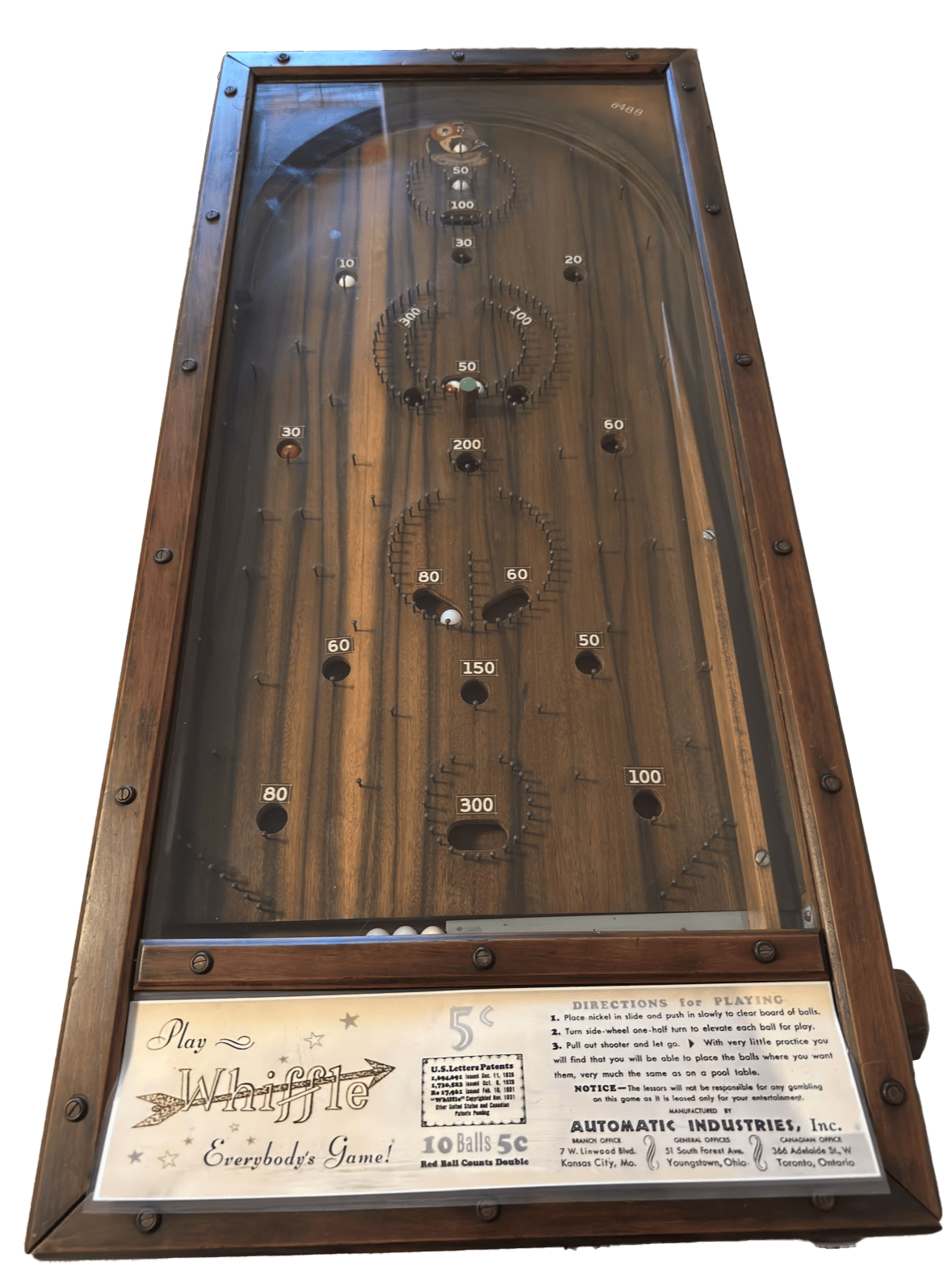About the Whiffle Machine - Page 2
Company and Production
Automatic Industries, based in Youngstown, Ohio, with additional offices in Kansas City, Missouri, and Toronto, Ontario, grew rapidly. Starting in a rented second-floor space, the company outgrew multiple locations before building its own facility due to overwhelming demand. Production peaked with orders averaging 2,000 units per month, exceeding $250,000 in contracted sales within a few years.
At its height, the company employed 53 shop workers and 13 office staff (11 men, 2 women), a significant contribution to Depression-era employment. The company produced several Whiffle variants, including "Champion Whiffle," "Improved Whiffle," "Whiffle Board Deluxe," "Baby Whiffle," "Whifflette," and "Whiffle-Zip," indicating an evolution of the original design. However, exact production totals remain elusive, and the company's eventual fate—whether it dissolved due to the pinball wars or economic shifts—is not well-documented. The lack of comprehensive records suggests either poor archiving or intentional obscurity during the legal battles that followed.
Design and Mechanics
The Whiffle machine, as seen in your photo, features a mahogany cabinet with brass hardware, a glass-covered wooden playfield, and a manual operation system. The playfield includes pins and numbered holes (e.g., 10, 20, 30, 50, 100, 150, 200, 300), with balls propelled by a spring-loaded plunger. For 5 cents, players receive 10 balls, with a "Red Ball Counts Double" feature. A side knob turns a wheel to lift balls to the playfield, and a shuttle board beneath returns balls to the base after each game, activated by a coin acceptor—a key innovation making it coin-operated.
The U.S. Patent No. 1,938,495, filed January 19, 1932, and issued December 5, 1933, by Paulin and Froome, details these mechanics. Figures 1-15 show a playfield with scoring circles and pins, a plunger mechanism (e.g., 14, 46), and a ball elevator (e.g., 29, 30). The patent emphasizes durability and ease of use, addressing issues like ball recirculation and player separation via glass—innovations attributed to Froome. However, the patent's focus on mechanical improvements over prior art (e.g., bagatelle games) suggests it built on existing concepts rather than inventing them outright.
Cultural Impact and Controversy
The Whiffle's wild popularity triggered a surge in similar games, sparking the "pinball patent wars." Competitors imitated the design, with one North Carolina company even using the Automatic Industries name, leading to legal battles. Racketeers reportedly smashed rival machines to replace them, and the game's gambling potential prompted disclaimers (e.g., "not responsible for any gambling") and seizures during the 1940s pinball raids. This contributed to the scarcity of surviving units, with only two known originals owned by Vintage Arcade Preservation Society members.
The narrative of Whiffle as the "birth of pinball" is contested. While it introduced modern pinball characteristics (plunger, coin mech, legs, glass), earlier games challenge its primacy. The Depression-era success reflects its affordability and appeal, but the gambling stigma and legal battles may have exaggerated its cultural footprint compared to its technical novelty.
Collector Value and Market
Today, Whiffle machines are rare, with the International Arcade Museum classifying them as "Rare" (2 known instances among active collectors, both original dedicated machines). A well-preserved unit in "immaculate condition" can fetch around $1,000, as noted in a 2017 Pinside listing with solid brass hardware and a mahogany cabinet (though missing a cashbox). Worn units, with issues like cracked molding, peeling veneer, or missing pins, typically range from $100-$200. A 1931 example owned for 20 years by a great-uncle was valued at a similar range due to condition flaws. The market varies by collector preference, with early games like Whiffle appealing less to those favoring later features (e.g., flippers, lights).
Critical Examination
The "first pinball" claim is a marketing legacy rather than a historical absolute. The barn board story, while charming, lacks evidence and may serve to romanticize Paulin's role—Froome's contributions to the coin mechanism and recirculation system were likely pivotal, yet his later claim as sole inventor (post-1947) suggests a possible rivalry or credit dispute. The rapid production scale and patent wars indicate a cutthroat industry where imitation outpaced innovation, raising questions about Automatic Industries' ability to protect its intellectual property.
The scarcity of machines may reflect both raids and the obsolescence of mechanical designs as electric pinball emerged, rather than just historical significance.
Conclusion
The 1931 Whiffle machine from Automatic Industries is a cornerstone of pinball history, bridging bagatelle games to modern pinball with its coin operation and playfield design. Its Depression-era success, driven by Paulin's ingenuity and Froome's commercialization, reshaped the amusement industry, though its "first" status is debated. As a rare collector's item, it holds both historical and monetary value, yet the narrative requires critical scrutiny due to gaps in evidence and the competitive context of its time.
